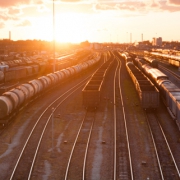The first German LNG terminal
Looking at the North Western European coastlines one can see a neat row of LNG terminals from the French Bretagne up to the Netherlands and after Denmark, it continues right into the Baltic Sea to Poland and now Lithuania.
What pops out, even more, is the gaping hole made up by Germany. The biggest, and most important European nation and economy, one of the biggest gas importers of the continent and a global economic heavyweight still does not call an LNG terminal its own.
Let’s dig into this for a while.
Germany was traditionally hooked into Russian, Norwegian and some Dutch pipeline gas supplies. This came in besides their own domestic production – which is paltry as compared to their actual needs. Not only is the country a voracious importer of gas, it had also decided to discontinue nuclear power plants plus its Energiewende has created one of the biggest renewable power industries on the planet. And this witches brew causes huge problems as electricity grids in Germany are on the brink of popping the cork.
There are – however – LNG terminals in almost all neighboring coastal countries so if the need ever arises, those sure could always be relied on in order to import LNG. Some German utilities have done exactly this when they booked capacity in GATE and in Grain.
Just building a terminal in order to close the gap on the map would not really be an intelligent proposal. If one has better alternatives to LNG, they must be explored by all means.
The North Stream pipeline has entrenched the Germans dependence on Russian gas even more and with North Stream 2 it would come so plentiful, Germans might be forgiven to believe that they don’t even need LNG.
However, Russia has become an unreliable supplier as the political price for Russian gas has become hard to bear. Besides, nowadays one must always consider Russian default today which would hurt the German economy badly. A credible alternative to Russian gas is in order.
Let’s run the economic odds of such a terminal proposal.
As of now, the planet faces the biggest wave of uncommitted LNG ever, and it sure looks like this oversupply situation is going to last well into the 2020ies. This gives any terminal developer on earth a very cheap and plentiful supply base to pick from. To understand this ex-problem better, one must know that LNG supply itself had been the single biggest problem for any LNG regasification project developer for around 10 years now. Everything paled in comparison.
Now it’s not only one problem less – but it has come full way around and the once painful undersupply situation transformed into one of the best opportunities for an LNG terminal that has ever adorned the face of the earth. In order to really understand the underlying rationale, you need to understand that concept of a sink terminal and this, in turn, forces me to take a wider look at the LNG world as it evolves right now.
LNG is not like oil – it’s not like any other energy product. Despite all the banter on the commoditization of LNG for the last couple of years, this is still a very exotic business with a limited set of players and very stiff supply lines. There is no generalized market for LNG yet which makes a generic valuation of anything almost impossible.
This means that in order to offer flexible supply deals to those clients that are ready to pay extra for delivery flexibility, you need to have a place where you can bring LNG produced when those premium clients don’t need it. I just said, there is no generalized market that allows you to sell off volumes quickly and cut your exposure while keeping the risk position in tight check. The worst position is that you have to emergency-sell the cargo far below value – making you lose a fortune.
Why would a client need such flexibility? Seasonality of demand is the first reason, but there are many others. LNG is produced in a stable flow of product throughout the year and it needs a commercial exit valve. It always needs a place to go and if the one place cannot take it for whatever reason, it needs an alternative.
And here – a potential German terminal proposal comes in. Such an exit valve for surplus LNG is called a sink terminal as such a terminal allows excess cargoes to be sunk into a market that will swallow it at any time and for almost any volume. This also means that the market is capable of swallowing big lumps of gas in short order and there are just not too many places like this on earth. North America is one, but shale gas has made this part of the world an export play and hence the sink distinction goes away.
The only other place that earns the title is North Western Europe, and with that I mean a short stretch of coastline from the french “Pas de Callais” up to the German city of Hamburg plus Southern England and Wales. This is the only other place on earth where a big, liberalized market complete with liquid gas hubs and plenty of storage and pipeline capacity exists.
There are 6 LNG receiving terminals currently operating in this area of the world, only 3 of them on the continental coast and none of them in Germany. And they are the only thing on earth between the biggest wave of LNG oversupply ever, and LNG liquefaction ventures potentially having to switch off multi-billion dollar terminals as the world cannot take the LNG anymore. Those receiving sink terminals will operate to the breaking point for a real long time and the LNG world sure can use all the relief those terminals can possibly provide.
Germany could use its own terminal not so much because it absolutely and desperately needs the gas but rather because as one of the biggest national gas markets, it can sure use the diversification measure to counterbalance its heavy exposure towards Russia. The LNG world needs Germany and will beat a path to its door and for the first time in decades, there are positive signs from German politics, both on the national as well as on the local level.
However, there are not many locations where such a terminal would work out in the country. One must be close to a high-pressure pipeline and the terminal should be on the western stretch of coastline, before Denmark. Most of this coast is an environmentally protected mudflat where even spitting is a punishable offense. Wilhelmshaven featured an eternal project that never happened. And there is one, maybe two others.
But they are all stuck in a rut and need professional development teams to pull them through. They also must start understanding that they have an opportunity to become one of the very few real LNG hubs on earth – an enviable position that opens possibilities from LNG flexibility services to back-loadings, from bunkering to LNG truck and potentially rail loading, from molecule trading to cold energy services. A German terminal – that has been built the right way – could face almost limitless economic opportunities.
The only limit being the project developers willingness to go professional and give some willing investors something to salivate for. Because opportunities don’t have a shelf life. When they are gone, they are just gone.














I think one reason for there not being a German LNG hub is the proximity to so many underutilised LNG import terminals along the coast in Britain, France, Belgium, Holland, Denmark, Poland and the Baltic States. There is currently no business case for one to be developed, in effect the GATE terminal is Germany’s main hub, it is also closer to Germanies industrial heartland in the Ruhr and fits well logistically.
Nicholas, thanks for your input. You are right – seen from today this makes absolute sense. There is underutilisation in all NW-European terminals right now. The onus lies on now. Wait for the US cranking up on their LNG production capacity and also the real effects of Asia’s wind-down in LNG use (Japan) fully blossoming and you will see those same terminals at the cracking point. Those things do happen very quick once they happen and we have the writings all over the wall. Then, everyone will squeal and wish they had a terminal but then it’s too late. Strategic thinking seems to be completely out of fashion in this “quarterly report” addicted world.